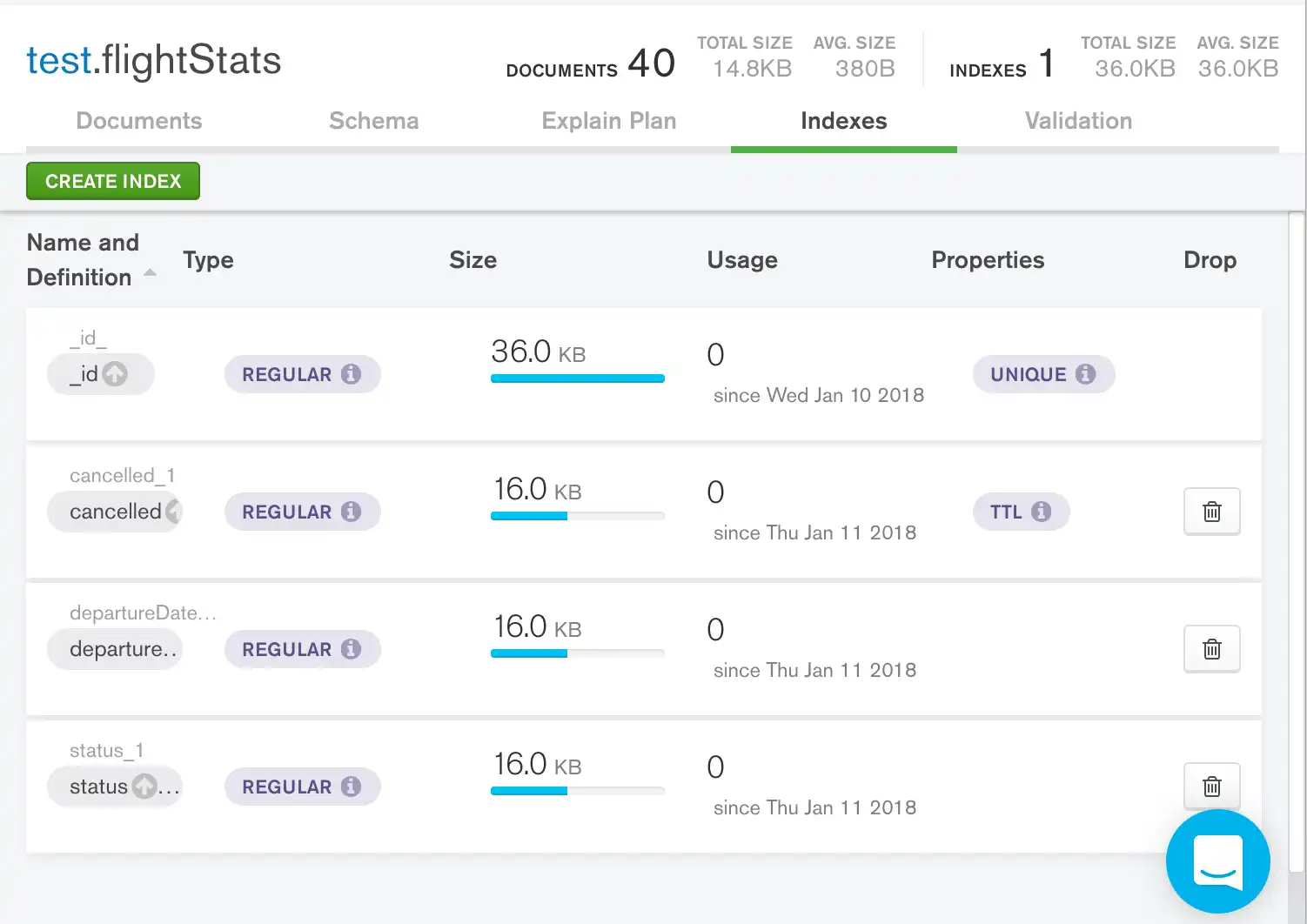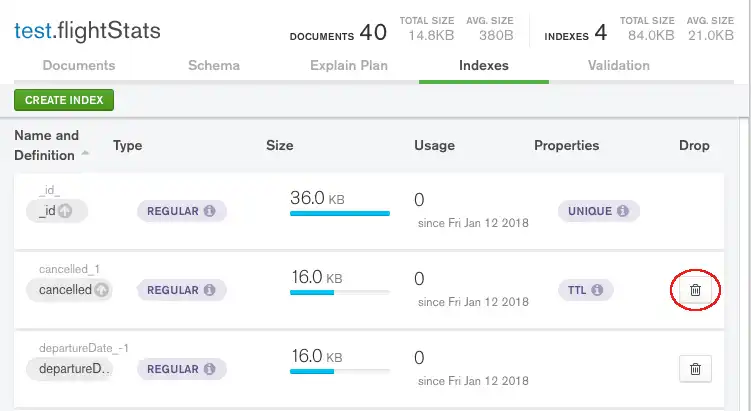This page shows how to manage existing indexes. For instructions on creating indexes, refer to the specific index type pages.
View Existing Indexes
The following sections provide methods for viewing existing indexes on a collection or an entire database.
List All Indexes on a Collection
To return a list of all indexes on a collection, use the
db.collection.getIndexes() method or a similar method
for your driver.
For example, to view all indexes on the people collection, run the
following command:
db.people.getIndexes()
List All Indexes for a Database
To list all the collection indexes in a database, run the following
command in mongosh:
db.getCollectionNames().forEach(function(collection) { indexes = db[collection].getIndexes(); print("Indexes for " + collection + ":"); printjson(indexes); });
List Specific Type of Indexes
To list all indexes of a certain type (such as hashed or text) for all
collections in all database, run the following command in
mongosh:
// The following finds all hashed indexes db.adminCommand("listDatabases").databases.forEach(function(d){ let mdb = db.getSiblingDB(d.name); mdb.getCollectionInfos({ type: "collection" }).forEach(function(c){ let currentCollection = mdb.getCollection(c.name); currentCollection.getIndexes().forEach(function(idx){ let idxValues = Object.values(Object.assign({}, idx.key)); if (idxValues.includes("hashed")) { print("Hashed index: " + idx.name + " on " + d.name + "." + c.name); printjson(idx); }; }); }); });
To view a list of all indexes on a collection in MongoDB Compass, click on the target collection in the left-hand pane and select the Indexes tab.

For details on the information displayed in this tab, refer to the Compass documentation.
Remove Indexes
Tip
Hide an Index Before Dropping It
If you drop an index that is actively used in production, your application may incur a performance degradation. Before you drop an index, you can evaluate the potential impact of the drop by hiding the index.
Hidden indexes are not used to support queries. If you hide an index and observe substantial negative performance impact, consider keeping and unhiding the index so queries can resume using it.
When removing indexes in the MongoDB Shell, you can either:
Remove a specific index.
Remove all indexes from the collection.
Remove Specific Index
To remove an index, use the db.collection.dropIndex() method.
For example, the following operation removes an ascending index on the
tax-id field in the accounts collection:
db.accounts.dropIndex( { "tax-id": 1 } )
The operation returns a document with the status of the operation:
{ "nIndexesWas" : 3, "ok" : 1 }
Where the value of nIndexesWas reflects the number of indexes
before removing this index.
For text indexes, pass the index name to the
db.collection.dropIndex() method. See Use the Index Name to Drop a text Index
for details.
Note
db.collection.dropIndexes() can accept an array
of index names.
db.collection.dropIndexes() can stop
in-progress index builds. See Stop In-Progress Index Builds
for more information.
Remove All Indexes
You can also use the db.collection.dropIndexes() to remove
all indexes except for the _id index from a
collection.
For example, the following command removes all indexes from
the accounts collection:
db.accounts.dropIndexes()
These shell helpers provide wrappers around the
dropIndexes database command. Your client
library may have a different or additional
interface for these operations.
To remove an index from a collection in MongoDB Compass:
Navigate to the collection containing the target index.
Click the Indexes tab.
In the Drop column for the target index, click the trash icon.

Modify an Index
To modify an existing index in the MongoDB Shell, you need to
drop and recreate the index. The exception to this rule is
TTL indexes, which can be modified
via the collMod command in conjunction with the
index collection flag.
To modify an existing index in MongoDB Compass, you need to drop and recreate the index.
Minimize Performance Impact With a Temporary Index
If you drop an index that is actively used in production, your application may incur a performance degradation. To ensure queries can still use an index during modification, you can create a temporary, redundant index that contains the same fields as the modified index.
Example
This example creates a new index and modifies that index to make it unique.
Recreate the { "url": 1 } index with the unique property
Run this command:
db.siteAnalytics.createIndex( { "url": 1 }, { "unique": true } )
The command returns the name of the index:
url_1
The url_1 index is recreated and you can drop the temporary
index without impacting performance. Queries on the url field
can use the new unique index.
Confirm that the index was updated
To view the indexes on the siteAnalytics collection, run this
command:
db.siteAnalytics.getIndexes()
The command returns these indexes, indicating that the url_1
index is now unique:
[ { v: 2, key: { _id: 1 }, name: '_id_' }, { v: 2, key: { url: 1 }, name: 'url_1', unique: true } ]
Find Inconsistent Indexes Across Shards
A sharded collection has an inconsistent index if the collection does not have the exact same indexes (including the index options) on each shard that contains chunks for the collection. Although inconsistent indexes should not occur during normal operations, inconsistent indexes can occur , such as:
When a user is creating an index with a
uniquekey constraint and one shard contains a chunk with duplicate documents. In such cases, the create index operation may succeed on the shards without duplicates but not on the shard with duplicates.When a user is creating an index across the shards in a rolling manner (i.e. manually building the index one by one across the shards) but either fails to build the index for an associated shard or incorrectly builds an index with different specification.
The config server primary, by default, checks
for index inconsistencies across the shards for sharded collections, and
the command serverStatus, when run on the config server
primary, returns the field shardedIndexConsistency
field to report on the number of sharded collections with index
inconsistencies.
If shardedIndexConsistency reports any index
inconsistencies, you can run the following pipeline for your
sharded collections until you find the inconsistencies.
Define the following aggregation pipeline:
const pipeline = [ // Get indexes and the shards that they belong to. {$indexStats: {}}, // Attach a list of all shards which reported indexes to each document from $indexStats. {$group: {_id: null, indexDoc: {$push: "$$ROOT"}, allShards: {$addToSet: "$shard"}}}, // Unwind the generated array back into an array of index documents. {$unwind: "$indexDoc"}, // Group by index name. { $group: { "_id": "$indexDoc.name", "shards": {$push: "$indexDoc.shard"}, // Convert each index specification into an array of its properties // that can be compared using set operators. "specs": {$push: {$objectToArray: {$ifNull: ["$indexDoc.spec", {}]}}}, "allShards": {$first: "$allShards"} } }, // Compute which indexes are not present on all targeted shards and // which index specification properties aren't the same across all shards. { $project: { missingFromShards: {$setDifference: ["$allShards", "$shards"]}, inconsistentProperties: { $setDifference: [ {$reduce: { input: "$specs", initialValue: {$arrayElemAt: ["$specs", 0]}, in: {$setUnion: ["$$value", "$$this"]}}}, {$reduce: { input: "$specs", initialValue: {$arrayElemAt: ["$specs", 0]}, in: {$setIntersection: ["$$value", "$$this"]}}} ] } } }, // Only return output that indicates an index was inconsistent, i.e. either a shard was missing // an index or a property on at least one shard was not the same on all others. { $match: { $expr: {$or: [ {$gt: [{$size: "$missingFromShards"}, 0]}, {$gt: [{$size: "$inconsistentProperties"}, 0]}, ] } } }, // Output relevant fields. {$project: {_id: 0, indexName: "$$ROOT._id", inconsistentProperties: 1, missingFromShards: 1}} ]; Run the aggregation pipeline for the sharded collection to test. For example, to test if the sharded collection
test.reviewshas inconsistent indexes across its associated shards:db.getSiblingDB("test").reviews.aggregate(pipeline) If the collection has inconsistent indexes, the aggregation for that collection returns details regarding the inconsistent indexes:
{ "missingFromShards" : [ "shardB" ], "inconsistentProperties" : [ ], "indexName" : "page_1_score_1" } { "missingFromShards" : [ ], "inconsistentProperties" : [ { "k" : "expireAfterSeconds", "v" : 60 }, { "k" : "expireAfterSeconds", "v" : 600 } ], "indexName" : "reviewDt_1" } The returned documents indicate two inconsistencies for the sharded collection
test.reviews:An index named
page_1_score_1is missing from the collection onshardB.An index named
reviewDt_1has inconsistent properties across the collection's shards, specifically, theexpireAfterSecondsproperties differ.
- To resolve the inconsistency where an index is missing from the collection on a particular shard(s),
You can either:
Issue an index build
db.collection.createIndex()from amongosinstance. The operation only builds the collection's index on the shard(s) missing the index.-OR-
Perform a rolling index build for the collection on the affected shard(s).
Note
Rolling indexes may negatively impact your deployment. For information on when to use this index build, see Rolling Index Builds.
Warning
Avoid performing rolling index and replicated index build processes concurrently as it might lead to unexpected issues, such as broken builds and crash loops.
- To resolve where the index properties differ across the shards,
Drop the incorrect index from the collection on the affected shard(s) and rebuild the index. To rebuild the index, you can either:
Issue an index build
db.collection.createIndex()from amongosinstance. The operation only builds the collection's index on the shard(s) missing the index.-OR-
Perform a rolling index build for the collection on the affected shard.
Note
Rolling indexes may negatively impact your deployment. For information on when to use this index build, see Rolling Index Builds.
Alternatively, if the inconsistency is the
expireAfterSecondsproperty, you can run thecollModcommand to update the number of seconds instead of dropping and rebuilding the index.